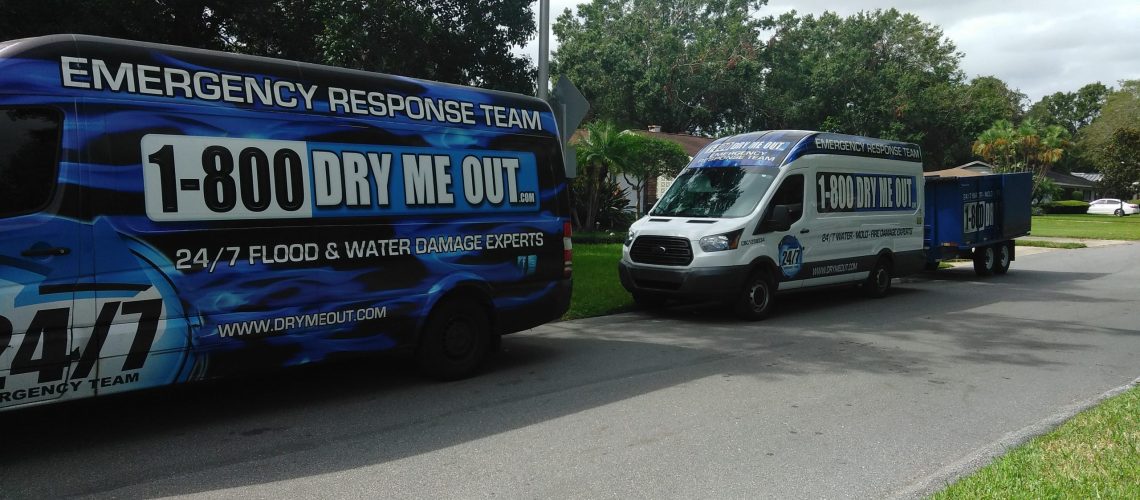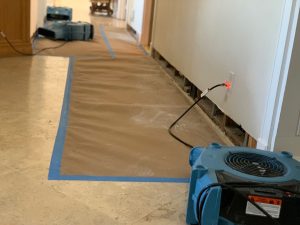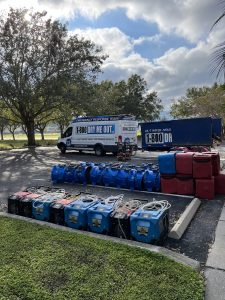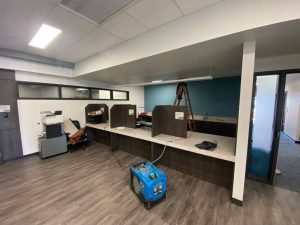Water damage can sneak up on you when you least expect it. One minute your property looks fine, and the next, you’re dealing with soaked floors, musty smells, or mysterious stains on the walls. At Dry Me Out, we’ve seen how quickly a small water issue can turn into a major problem when it’s not handled promptly and properly. Whether it’s from a storm, a broken pipe, an overflowing appliance, or hidden leaks, water damage doesn’t just go away on its own, it actually gets worse over time.
We put together this comprehensive water damage checklist to help you know exactly what to look for and what to do if you think water has invaded your home or business. Whether you’re dealing with a current issue or just trying to stay prepared, this guide will walk you through the essential signs of water damage, what steps to take immediately, and how to prevent long-term damage to your property.
Key Takeaways
- Look for signs like stains, musty smells, warped floors, or bubbling paint to identify possible water damage.
- Turn off water and electricity if there’s a leak or standing water, always prioritize safety.
- Document the damage for insurance purposes and call a professional restoration team right away.
- Use a comprehensive inspection checklist to assess ceilings, walls, floors, appliances, and hidden areas.
- Act fast—mold can start growing within 24-48 hours of water exposure.
- Dry thoroughly using professional equipment like dehumidifiers and air movers to prevent hidden moisture and future issues.
- Prevent future damage by maintaining appliances, monitoring water bills, and inspecting your home regularly.
- Call professionals like Dry Me Out for large or hidden water damage issues. We have the tools and experience to protect your property.
1. Signs of Water Damage: What to Look For
Water damage doesn’t always show up as a flood in the living room. Some of the most destructive water damage issues are the sneaky, slow ones that develop behind walls or under floors. Keep an eye out for these telltale signs:
Visible Clues
- Water stains or discoloration on walls or ceilings, especially brownish rings
- Warped or bubbling paint or wallpaper
- Sagging ceilings or drywall
- Warped or buckling floors (wood, tile, or laminate)
- Mold or mildew growth, even in small patches
- Musty or damp odors in rooms, closets, or crawlspaces
Hidden Clues
- Unexpected increase in water bills, indicating a hidden leak
- Sounds of dripping, running, or rushing water when fixtures are off
- Soft or spongy spots in the flooring
- Condensation on windows or walls, particularly in non-humid weather
2. Immediate Steps to Take After Discovering Water Damage
When you notice signs of water damage, time is not on your side. Acting quickly can help limit the damage and reduce the overall cost of repairs. Here’s what you should do right away:
Shut Off the Water Source (If Safe)
- If the issue is caused by a plumbing leak or burst pipe, locate your home’s main shut-off valve and turn it off.
- For appliance-related issues (washing machines, dishwashers), turn off the appliance and unplug it from the wall.
Turn Off Electricity (If Needed)
- If water has reached outlets, appliances, or electrical panels, shut off the electricity in that area to prevent risk of shock.
Document the Damage
- Take clear photos and videos of all visible damage. This documentation will be important for insurance claims and for professional assessments.
Call a Water Damage Professional
- Don’t try to handle major water damage on your own. Contact a restoration company like Dry Me Out immediately. We’re trained to assess the damage, begin safe cleanup, and prevent mold and structural issues.
Notify Your Insurance Company
- Call your insurance provider to start the claims process. Share the documentation you gathered and follow their guidance for next steps.
3. Inspection Checklist: Assessing the Damage Thoroughly
Once the situation is under control, it’s time to evaluate the full scope of the damage. This is best done by professionals, but here are some areas to check:
Structural Areas
- Ceilings: Check for sagging, discoloration, and cracking.
- Walls: Look for bubbling paint, damp drywall, or mold.
- Floors: Examine flooring for warping, lifting, or staining.
- Doors & Windows: Ensure frames haven’t swollen or shifted.
Plumbing Fixtures & Appliances
- Inspect all water-connected appliances (toilets, sinks, tubs, washing machines, water heaters).
- Look under sinks for pooled water, soft cabinets, or warped wood.
Hidden Spaces
- Basements & crawlspaces: These areas are prone to lingering moisture and mold growth.
- Attics: Check for roof leaks, wet insulation, or mold around rafters.
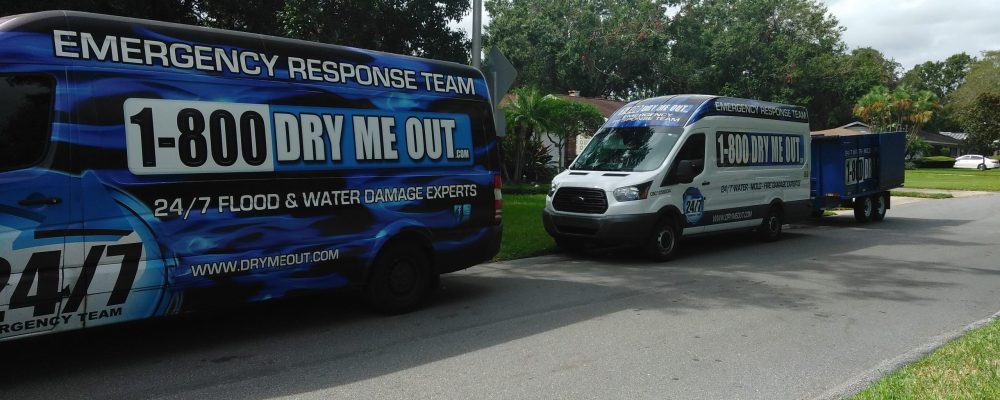
4. Drying and Water Removal Process
Proper drying is absolutely critical to preventing further damage, especially mold. Here’s what should happen next:
Water Extraction
- High-powered pumps and vacuums are used to remove standing water from floors, carpets, and walls.
Drying & Dehumidifying
- Industrial-grade air movers and dehumidifiers are set up to pull moisture from the air and building materials.
- Moisture meters are used to monitor progress and ensure no damp spots are left behind.
Cleaning and Sanitizing
- Affected areas are cleaned and treated with antimicrobial solutions to prevent mold growth and odors.
At Dry Me Out, we use advanced moisture detection tools to make sure every inch is thoroughly dried, even behind your walls and under the floors.
5. When to Call a Professional vs. DIY
There’s a big difference between a minor spill and actual water damage. Here’s how to know whether to call in a professional:
DIY Situations (Usually Safe to Handle Yourself):
- Minor spills or small puddles on non-porous surfaces
- Water that didn’t soak into walls, flooring, or insulation
- Clean water that was mopped up quickly with no signs of spread
Call a Professional Immediately If:
- Water is coming from a contaminated source (like sewage or floodwater)
- You can’t locate the source of the leak
- Water soaked into carpet, hardwood, drywall, or insulation
- You see visible mold growth
- There’s a musty smell that won’t go away
- Damage has affected structural areas (walls, ceilings, subfloors)
6. The Mold Factor: Why You Can’t Ignore It
Mold can start growing within 24 to 48 hours after water damage occurs. Even if the area looks dry on the surface, hidden moisture can give mold the perfect environment to spread.
If mold growth begins, you may notice:
- A strong, musty odor
- Dark or fuzzy spots on surfaces
- Aggravated allergy or asthma symptoms
At Dry Me Out, we use specialized tools to detect hidden moisture and take preventive measures against mold. If we find signs of mold, we’ll guide you through the next best steps, including professional testing if needed.
7. Preventing Future Water Damage
Prevention is key. While you can’t stop every storm or appliance malfunction, you can lower your risk with a few proactive steps:
Tips for Homeowners:
- Inspect your roof and gutters regularly for leaks or debris
- Seal windows and doors to prevent rainwater intrusion
- Install a sump pump in your basement
- Keep an eye on your water bill for unexplained increases
- Install water leak detectors near appliances and under sinks
Maintenance Habits:
- Clean out gutters at least twice a year
- Test your sump pump annually
- Inspect hoses and supply lines on appliances
- Know where your main water shutoff valve is—and how to use it
8. Why Choose Dry Me Out for Water Restoration
At Dry Me Out, we’ve helped thousands of homeowners and business owners get their properties and their peace of mind back after water damage. We bring years of experience, top-tier equipment, and a people-first attitude to every job. Our team is friendly, fast, and always focused on doing the job right the first time.
Whether you’re dealing with an emergency or just want a professional inspection, we’re here to help 24/7. We believe in making the restoration process as smooth and stress-free as possible.
Water damage can feel overwhelming, but you don’t have to deal with it alone. With the right steps, and the right help, you can protect your home, your health, and your peace of mind. If you need expert guidance or emergency water damage cleanup, reach out to Dry Me Out any time. We’re always just a call away.

